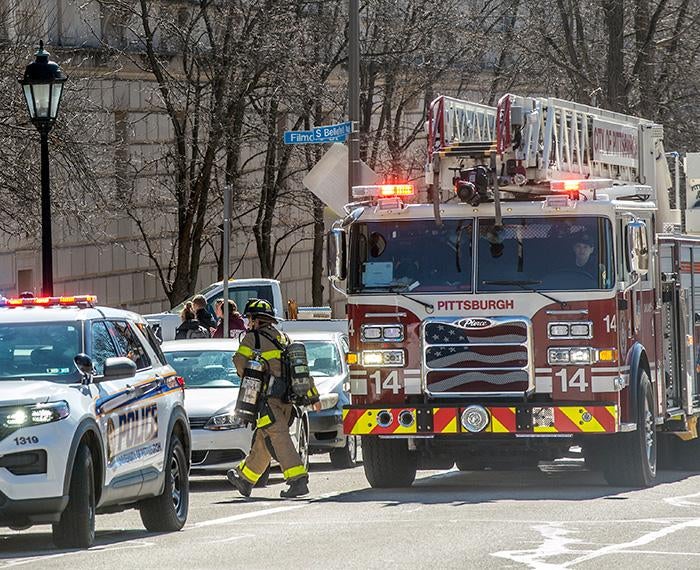
Subscribe to Pittwire Today
Get the most interesting and important stories from the University of Pittsburgh.Evacuation and fire safety reminders

If you need to evacuate a building on campus, you should familiarize yourself with the sights, sounds and procedures developed by Office of Public Safety and Emergency Management. Chimes, horns, voice messages and/or strobe lights will notify occupants of the need to leave.
These systems are arranged for either full building notification or zoned alarm notification. Specific building design features that enhance life safety allow the use of a zoned notification system.
When an alarm signals on your floor, note what the audible message says and evacuate the building immediately.
Fire alarm procedures
If you notice a fire, alert anyone in immediate danger and activate the nearest fire alarm pull station (located along the egress route). Close doors to contain smoke or fire, and evacuate the building via designated stairwells and exterior exit doors. DO NOT USE THE ELEVATOR.
The typical zoned fire alarm system is designed to activate an audible signal and visual alarm on the floor of emergency, one floor above and one floor below.
During a fire alarm, visual signals — strobe lights — will flash and audible signals — chimes or horns — will sound. A voice message will also play a message such as: “May I have your attention please? A fire emergency has been reported in the building. Please leave the building by the nearest exit. Do not use the elevators.” The audible and visual alerts will be continuous.
Once you arrive at your designated assembly area, call 412-624-2121 to alert public safety personnel. Do not re-enter the building until University police or fire department personnel give the “all clear” signal.
Read more about fire safety at Pitt.
What to do during an emergency evacuation
If it is safe to do so, call 412-624-2121 or 911 to report the situation. Classroom instructors are expected to interrupt class activity and tell students to evacuate the building when the alarm activates. Faculty, staff and students are obligated to follow emergency procedures and obey the directions of emergency response personnel.
During a security evacuation, there will be a visual signal of strobe lights and there will be an audible signal of chimes or horns followed by a voice message such as: “May I have your attention please? A security alert has been reported. Please leave the building by the nearest exit. Do not use the elevators.” The audible and visual alerts will be continuous.
Follow the egress path designated by EXIT signs. DO NOT USE THE ELEVATOR in a building under alarm conditions unless directed to do so by an emergency responder. Stairwells provide areas of refuge within the building and provide safe egress from the building.
Upon exiting, move away from the building and proceed to the pre-determined assembly area. This reduces your exposure to hazardous conditions, allows for others to safely exit and provides a clear area for emergency responders to do their job. Do not attempt to re-enter the building until University police or fire department personnel give the “all clear” signal.
Find the assembly area for the buildings you frequent, as well as more safety information specific to each space.
Emergency evacuation training opportunities
The University of Pittsburgh Environmental Health and Safety Department (EH&S) conducts semi-annual evacuation exercises for University residence halls, University-owned fraternity houses and University-owned apartments. Annual evacuation exercises are performed for all other high-rise academic buildings. University departments may request an evacuation drill for their building by contacting EH&S at 412-624-9505 or emailing safety [at] pitt.edu.
If you need further assistance
Faculty, staff and students who have a disability or other circumstances that may prevent them from following the evacuation plan should contact EH&S by calling 412-624-9505 or emailing safety [at] pitt.edu to develop an individual evacuation plan. Copies of these plans are maintained with University Police for use by emergency responders.

